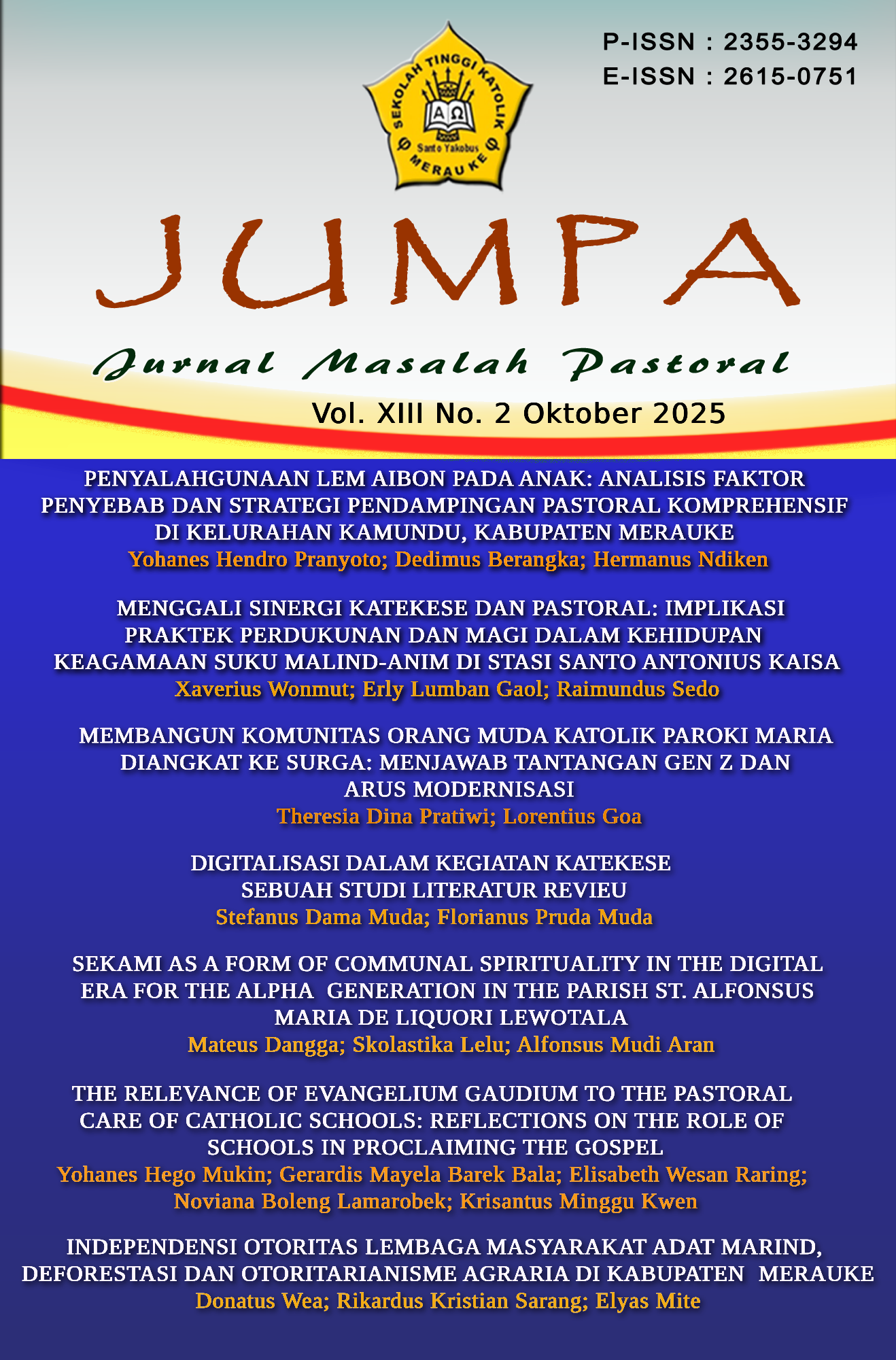ABUSE OF AIBON GLUE AMONG CHILDREN: ANALYSIS OF CAUSAL FACTORS AND COMPREHENSIVE PASTORAL COUNSELLING STRATEGIES IN KAMUNDU VILLAGE, MERAUKE REGENCY
DOI:
https://doi.org/10.60011/jumpa.v13i2.240Keywords:
Abuse of Aibon Glue, Minors, Causative Factors, Pastoral Impact, Preventive-Curative AssistanceAbstract
The misuse of glue among minors is a phenomenon that is gaining increasing attention due to its serious impact on children's physical and psychological health. This study aims to identify the underlying factors that cause deviant behaviour among minors, as well as to describe the impact of glue sniffing on child development and the preventive and curative measures that can be taken. Using a descriptive qualitative approach with observation, interviews, and documentation methods, this study explores the internal, external, and social factors that contribute to glue sniffing. The research informants consisted of ten people, including glue sniffers, parents, mentors, community leaders, and environmental managers in Kamundu Village, Merauke Regency, South Papua, Indonesia. The results of the study show that the main contributing factors include a lack of supervision and attention from the family, the influence of the environment and peers, economic factors, a lack of understanding about the dangers of glue sniffing, and the easy availability of glue. The impacts experienced by children include physical growth disorders, mental disorders, and decreased cognitive function. Preventive and curative efforts involve a holistic approach that combines family guidance, community education, pastoral support from the Church, and government policies. The study concluded that addressing the problem of glue abuse requires intensive collaboration between parents, the community, the church, and the government to protect children from the adverse effects of substance abuse.
References
Desmita. (2009). Psikologi perkembangan peserta didik: Panduan bagi orang tua dan pendidik dalam memahami psikologi anak usia SD hingga SMA. Bandung: Remaja Rosdakarya.
Djamarah, S. B. (2014). Pola asuh orang tua dan komunikasi dalam keluarga: Upaya membangun citra positif membentuk kepribadian anak. Bandung: Rineka Cipta.
Gunarsa, S. D. (2008). Psikologi perkembangan anak dan remaja. Jakarta: BPK Gunung Mulia.
Hawari, D. (2010). Alkohol dan narkoba: Perspektif agama, medis, dan sosial budaya. Jakarta: Fakultas Kedokteran Universitas Indonesia.
II, P. Y. (2011). Familiaris Consortio: Anjuran apostolik tentang peran keluarga Kristiani di dunia modern. Jakarta: Obor Indonesia.
Indonesia, P. R. (2002). Undang-Undang Republik Indonesia Nomor 23 Tahun 2002 Tentang perlindungan anak. Lembaran Negara Republik Indonesia, 109, 2002. Jakarta, Indonesia.
Keluarga, P. P. (2011). Pedoman pastoral keluarga Gereja Katolik Indonesia. Jakarta: Komisi Keuskupan Komunitas Jemaat.
Kusuma, H. (2022). Dampak paparan lem aibon terhadap fungsi organ internal anak. Jurnal Kesehatan Anak, 14(3), 113-120.
Labetubun, S. D. (2018). Faktor-faktor yang mempengaruhi perilaku ngelem pada anak jalanan di Kota Merauke. Jurnal Kesehatan Masyarakat Papua, 12(3), 156-172.
Lestari, S. (2012). Psikologi keluarga: Penanaman nilai dan penanganan konflik dalam keluarga. Jakarta: Kencana Prenada Media.
Downloads
Published
How to Cite
Issue
Section
License
Copyright (c) 2025 Yohanes Hendro Pranyoto, Dedimus Berangka, Hermanus Ndiken

This work is licensed under a Creative Commons Attribution-NonCommercial-NoDerivatives 4.0 International License.










